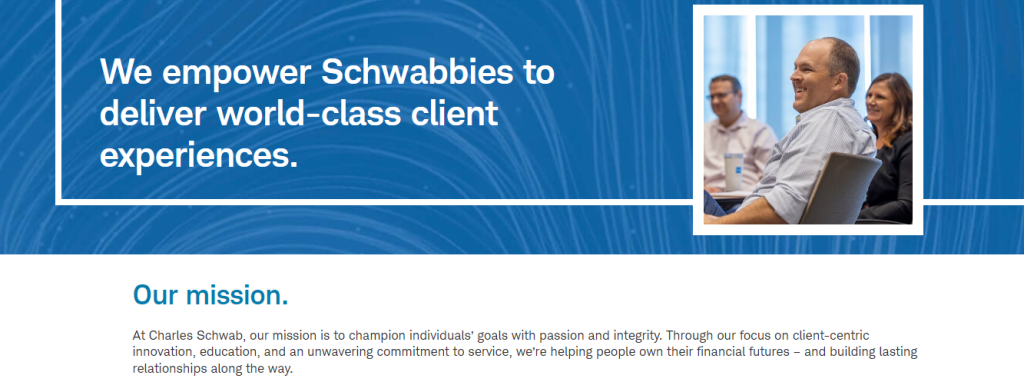Table of Contents
ToggleA Brief History of Charles Schwab
The Charles Schwab Corporation, commonly known as Charles Schwab, is a leading financial services company that was founded in 1971 by Charles R. Schwab in San Francisco, California. The company originally started as a traditional brokerage firm but quickly became a pioneer in the discount brokerage industry, offering lower commission fees to individual investors.
In the 1980s and 1990s, Charles Schwab continued to grow and expand its range of services, including introducing online trading and opening its own line of mutual funds. The company also acquired several other financial firms, further solidifying its position in the industry.
In the 2000s, Charles Schwab faced challenges during the dot-com bubble burst and the financial crisis but emerged as a stronger and more diversified company. It continued to innovate and adapt to the changing landscape of the financial industry, offering new products and services such as robo-advisors and investment management.
Today, The Charles Schwab Corporation is one of the largest brokerage firms in the United States, serving millions of clients with a wide range of financial services, including brokerage, banking, and wealth management. Charles Schwab is known for its commitment to providing accessible and affordable investment options for individual investors, and its reputation as a trusted and reliable financial partner.
Who Owns Charles Schwab?
The Charles Schwab Corporation is owned by a number of shareholders, both individual and institutional. As of the most recent data available, the top 10 shareholders of the company are as follows:
1. The Vanguard Group, Inc.
2. BlackRock, Inc.
3. State Street Corporation
4. FMR LLC (Fidelity)
5. Capital World Investors
6. T. Rowe Price Associates, Inc.
7. Northern Trust Corporation
8. Bank of America Corporation
9. Geode Capital Management, LLC
10. Invesco Ltd.
These institutional investors, along with individual shareholders, collectively own the Charles Schwab Corporation and hold significant influence over the company’s operations and direction.
Charles Schwab Mission Statement

The Charles Schwab Corporation’s mission statement is to provide customers with a full range of financial services that are grounded in integrity, trust, and transparency. They aim to empower individuals to take control of their financial futures, with a strong commitment to delivering innovative and accessible products and services. The company also prioritizes giving back to the community through philanthropy and volunteer work, embodying their dedication to making a positive impact beyond the financial realm.
How Charles Schwab Makes Money?
The Charles Schwab Corporation operates as a leading brokerage and banking company, with a business model focused on providing a range of financial services to individual investors and institutions. The company generates revenue primarily through various channels, such as net interest income from its banking services, fees and commissions from investment products and services, and asset management fees. Additional revenue streams come from trading transaction fees, fees for advisory services, and other financial products offered to its clients. Charles Schwab’s business model is centered on providing a comprehensive suite of financial services, aiming to generate sustainable revenue streams through a diverse range of products and offerings.
Charles Schwab Business Model Canvas
Business Model Canvas is a strategic management tool used to describe, design, challenge, invent, and pivot a business model. It consists of nine subheadings, which are Customer Segments, Value Propositions, Channels, Customer Relationships, Revenue Streams, Key Resources, Key Activities, Key Partners, and Cost Structure. Each subheading helps to understand and visualize the key elements of a business model in a clear and concise manner.
Customer Segments:
1. Individual Investors: Charles Schwab provides investment services to individual investors looking to manage their own portfolios.
2. Institutional Investors: The company also caters to institutional investors such as pension funds, endowments, and foundations.
Value Propositions:
1. Low-Cost Trading: Charles Schwab offers low-cost trading and investment services, making it an attractive option for cost-conscious individuals and institutions.
2. Access to Research and Education: The company provides access to research and educational resources to help customers make informed investment decisions.
Channels:
1. Online Platform: Charles Schwab offers an online trading platform for customers to place trades, and access account information, and educational resources.
2. Physical Branches: The company also has physical branch locations for customers who prefer in-person assistance and support.
Customer Relationships:
1. Self-Service: Customers can use the online platform for self-service trading and account management.
2. Personalized Support: Charles Schwab provides personalized support through phone, chat, and in-person consultations.
Revenue Streams:
1. Commission Fees: The company generates revenue through Commission fees from trades placed by customers.
2. Asset Management Fees: Charles Schwab also earns revenue through asset management fees from managing clients’ investment portfolios.
Key Resources:
1. Trading Platform: The online trading platform is a key resource for the company.
2. Research and Education: Access to research and educational resources is essential for customer engagement.
Key Activities:
1. Trading and Investment Services: Charles Schwab’s key activity is providing trading and investment services to its customers.
2. Customer Support: The company also focuses on providing excellent customer support and service.
Key Partners:
1. Financial Institutions: Charles Schwab partners with financial institutions to offer a range of investment and financial products to its customers.
2. Technology Providers: The company partners with technology providers to enhance its online trading platform and customer experience.
Cost Structure:
1. Employee Salaries: The Company incurs costs related to employee salaries and benefits.
2. Technology Infrastructure: Charles Schwab invests in technology infrastructure to support its online platform and customer experience.
Overall, The Charles Schwab Corporation operates with a business model that focuses on providing affordable and accessible investment services to individual and institutional investors through various channels and strategic partnerships, while also continually investing in resources and activities to support its key value propositions and revenue streams.
Charles Schwab’s Competitors
The Charles Schwab Corporation faces competition from a number of major financial services companies in the market. Some of its top competitors include:
1. Fidelity Investments
2. TD Ameritrade
3. E*TRADE Financial
4. Vanguard Group
5. Interactive Brokers Group
These companies offer similar investment and wealth management services, and compete with Charles Schwab for market share and customer loyalty. With a highly competitive industry landscape, these companies are constantly innovating and offering new products and services to attract and retain clients.
Charles Schwab SWOT Analysis
Strengths:
1. Strong brand recognition and reputation in the financial services industry
2. Robust and diversified product offerings including brokerage, banking, and wealth management services
3. Extensive network of branches and online presence for convenient customer access
4. Emphasis on technological innovation and digital platforms for enhanced customer experience
Weaknesses:
1. Dependence on market conditions for revenue generation
2. Vulnerability to regulatory changes and compliance issues
3. Limited international presence compared to some competitors
4. Potential for client attrition in a highly competitive industry
Opportunities:
1. Potential for growth in the digital investing and robo-advising space
2. Expansion into international markets for diversification and growth opportunities
3. Increasing demand for sustainable and socially responsible investment options
4. Acquisitions and partnerships to expand service offerings and reach new customer segments
Threats:
1. Economic downturns and market volatility affecting investment performance
2. Disruption from fintech companies and new entrants in the financial services industry
3. Regulatory changes impacting business operations and compliance costs
4. Potential for cybersecurity breaches and data privacy concerns influencing customer trust
Concluding Analysis
After analyzing the business model of The Charles Schwab Corporation, I am optimistic about the future of the company. With its focus on innovation and technology, combined with a strong commitment to providing value to its customers, I believe that the Charles Schwab Corporation is well-positioned to continue its success in the financial industry. The growing popularity of digital investing and the company’s ability to adapt to changing market trends further solidify my confidence in its future prospects. As an analyst, I see great potential for The Charles Schwab Corporation to maintain its position as a leader in the industry and continue to deliver strong results for its shareholders.
Additional Resources
To keep learning and advancing your career, we highly recommend these additional resources:
Business Model Canvas of The Top 1,000 Largest Companies by Market Cap in 2024
A List of 1000 Venture Capital Firms & Investors with LinkedIn Profiles
Peter Thiel and the 16 Unicorns: The Legacy of Thiel Fellowship












